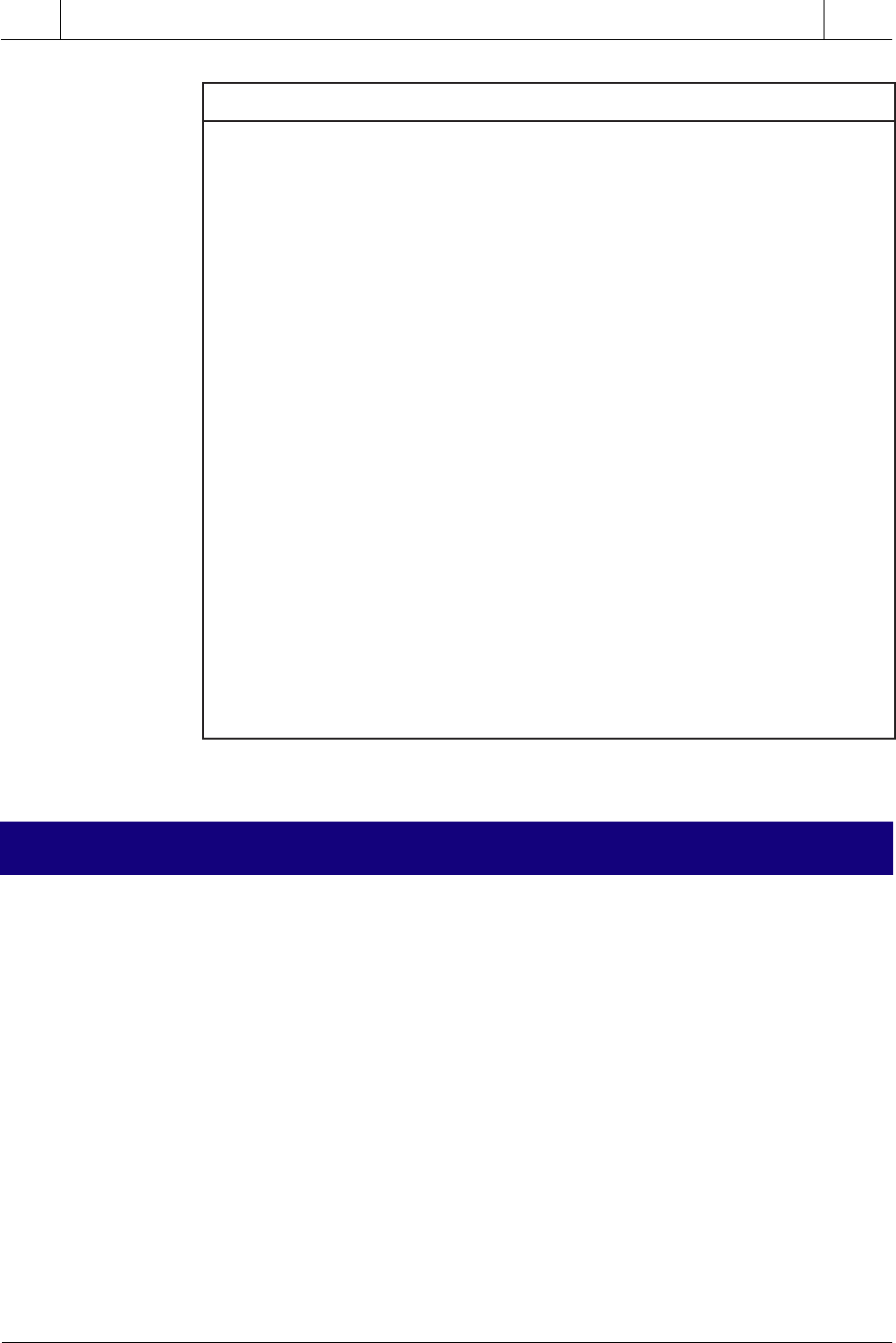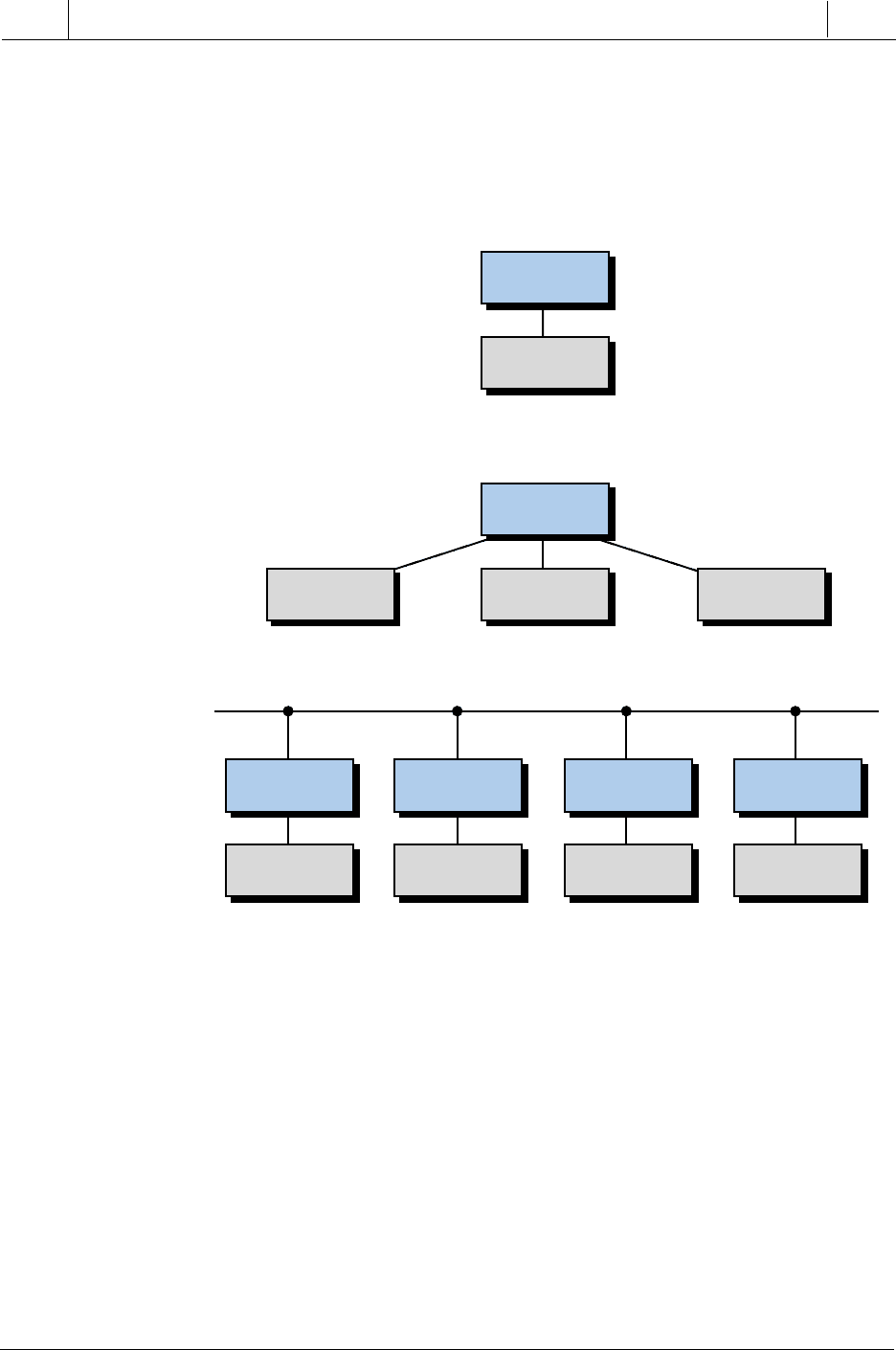Bryan L. Programmable controllers. Theory and implementation
Подождите немного. Документ загружается.


969
CHAPTER
21
System Selection
Guidelines
SECTION
6
Installation
and Start-Up
Industrial Text & Video Company 1-800-752-8398
www.industrialtext.com
Table 21-5. Standard features of very large PLCs.
21-3 PROCESS CONTROL SYSTEM DEFINITION
sCLPegraLyreV
O/I2918otpU•seitilibapachtaM•
srossecorpitlumrorossecorptib-23•noitiddA–
lortnocgolanadnarecalperyaleR•noitcartbuS–
sdrowK46otpuyromeM•noitacilpitluM–
gem1otelbadnapxE•noisiviD–
O/IlatigiD•toorerauqS–
O/IgolanA•noisicerpelbuoD–
O/IgolanaetomeR•tniopgnitaolF–
seludomlaicepsetomeR•snoitcnufenisoC–
O/IetomerdnalacoL•gnildnahatadlufrewoP•
egaugnalnaelooBroreddaL•erapmoC–
egaugnallevel-hgih/kcolbnoitcnuF•noisrevnocataD–
syalerlortnocretsaM•elif/retsigerevoM–
sretsigertfihs/sretnuoc/sremiT•snoitcnufxirtaM–
srecneuqesdnasremitmurD•refsnartkcolB–
pmuJ•selbatyraniB–
stpurretni,senituorbuS•selbatIICSA–
seludomO/InoitcnuflaicepS•OFIL–
skrowtenaeralacoL•OFIF–
DIPerawtfosmetsysroseludomDIP•scitsongaidenihcaM•
stropnoitacinummoc232-SReromroowT• skrowtensubO/ItroppuS•
seludomnoitacinummocretupmoctsoH•
Selecting the right programmable controller for a machine or process in-
volves evaluating not only current needs, but future requirements as well. If
present and future goals are not properly evaluated, the control system may
quickly become inadequate and obsolete.
Keeping the future in mind when choosing a programmable controller will
minimize the costs of changes and additions to the system. For example, with
proper planning, future memory expansion may only require the installation
of a memory module; furthermore, the addition of a peripheral may be as easy
as connecting the device to the communication port. A local area network can
also ease the future integration of programmable controllers into a plantwide
communication scheme.
Once the basic control application has been defined, the user should begin
evaluating the controller requirements, including:

970
SECTION
6
Installation
and Start-Up
Industrial Text & Video Company 1-800-752-8398
www.industrialtext.com
CHAPTER
21
System Selection
Guidelines
• input/output
• type of control
• memory
• software
• peripherals
• physical and environmental
INPUT/OUTPUT CONSIDERATIONS
Determining the amount of I/O required is typically the first step in selecting
a controller. Once the decision has been made to automate a machine or
process, determining the amount of I/O is simply a matter of counting the
discrete and/or analog devices that will be monitored or controlled. This count
will help to identify the minimum size constraints for the controller. Remem-
ber that the controller should allow for future expansion and spares (typically
10% to 20% spares), although spares do not affect the choice of PLC size.
Discrete Inputs/Outputs. Input/output interfaces with standard ratings are
available for accepting signals from sensors and switches (e.g., push buttons,
limit switches, etc.), as well as ON/OFF control devices (e.g., pilot lights,
alarms, motor starters, etc.). If these input/output devices receive power from
separate sources, then the discrete interface circuits must have isolated
commons (return lines). Typical discrete AC inputs/outputs range from 24 to
240 V, and typical DC inputs/outputs range from 5 to 240 V.
Input circuits vary from one manufacturer to another. Nevertheless, charac-
teristics like debouncing circuitry, which protects against false signals, and
surge protection, which guards against large transients, are desirable in any
input circuit. Another good input circuit quality is optical or transformer
isolation between the high-power input and the interface’s control logic
circuitry.
When evaluating discrete outputs, the following are key characteristics:
fuses, transient surge protection, and isolation between the power and logic
circuits. Fused circuits cost more initially, but they usually cost less than
having a fuse installed externally. These circuits should also have easily
accessible fuses, so that replacing fuses does not require shutting down
several other devices for a long period of time. Moreover, fused output
circuits should have blown fuse indicators, as well as an output current rating
and a specified operating temperature (typically 60°F) that fits the
application’s requirements.
Analog Inputs/Outputs. Analog input/output interfaces sense signals gen-
erated by transducers. These interfaces measure quantity values, such as flow,

971
CHAPTER
21
System Selection
Guidelines
SECTION
6
Installation
and Start-Up
Industrial Text & Video Company 1-800-752-8398
www.industrialtext.com
temperature, and pressure, and are used to control voltage or current output
devices. Typical interface ratings include –10 to +10 V, 0 to +10 V, 4 to 20
mA, and 10 to 50 mA.
Some manufacturers provide special analog interfaces that accept low-level
signals (e.g., RTD, thermocouple). Typically, these interface modules accept
a mix of thermocouple or RTD signals on a single module. Users should
consult the vendor concerning specific requirements.
Special Function Inputs/Outputs. Sometimes an application requires a
special type of I/O conditioning (e.g., positioning, fast input, frequency,
etc.) that may be impossible to implement using standard I/O modules.
Special function I/O modules and smart modules, a type of special interface,
can perform this task. Typically, these interfaces process all of the field data
within the module itself, thus relieving the CPU from performing this time-
consuming duty. For example, PID, three-axis positioning, and stepper motor
modules are special function I/O modules that make control implementation
much easier. These modules reduce programming and implementation time.
Remote Inputs/Outputs. Remote I/O modules are convenient, cost-effec-
tive processing devices, especially when used in large systems. Remote I/O
subsystems, which are located away from the CPU and connected to it by
twisted-pair cables, can dramatically reduce wiring costs, both from a labor
and a material standpoint. Another advantage of remote I/O subsystems is that
inputs and outputs can be strategically grouped to control separate machines
or sections of a machine or process. This grouping provides easy maintenance
and allows start-up without involving the entire system.
Most controllers that have remote I/O have remote digital I/O. However,
users who require remote analog I/O should check to see if this feature is
available in the products being considered.
I/O Bus Networks. I/O bus networks, which include device bus and process
bus networks, should be considered in applications requiring decentralized
control within the PLC system. I/O bus networks provide a topology that
allows the direct connection of field devices to a bus network, thereby
simplifying wiring. At the same time, these networks let the PLC directly
receive I/O field device information about the status of the device. However,
the system’s I/O field devices must be compatible with the I/O bus network
to take advantage of these enhanced communications features.
CONTROL SYSTEM ORGANIZATION
With the advent of new, smarter programmable controllers, the decision
about the type of control has become a very important consideration.
Questions such as, What type of control should I use? are now asked more

972
SECTION
6
Installation
and Start-Up
Industrial Text & Video Company 1-800-752-8398
www.industrialtext.com
CHAPTER
21
System Selection
Guidelines
often when automating a process. Knowing process application and future
automation requirements will help the user to decide what type of control,
and thus PLC, is required. Possible control configurations include individual
control, centralized control, and distributed control. Figure 21-9 illustrates
these configurations.
Figure 21-9. (a) Individual, (b) centralized, and (c) distributed control configurations.
Individual Control. Individual control, or segregated control, is used
when a PLC controls a single machine with only local I/O or with local and
a few remote I/O. This type of control does not normally require communi-
cation with any other controllers or computers. Individual control is primarily
applied to OEM and end-user equipment, such as injection-molding ma-
chines, small machine tools, and small, dedicated batching processes. When
deciding on this approach, the user should consider whether future
intercontroller communication will be desired. If so, the user can choose the
appropriate controller for the initial installation to avoid extra design ex-
penses at a later date.
PLC
Machine
PLC
MachineMachine Machine
PLC
Machine
PLC
Machine
PLC
Machine
PLC
Machine
(a) Individual control
(b) Centralized control
(c) Distributed control
(a) Individual control
(b) Centralized control
(c) Distributed control

973
CHAPTER
21
System Selection
Guidelines
SECTION
6
Installation
and Start-Up
Industrial Text & Video Company 1-800-752-8398
www.industrialtext.com
Centralized Control. Centralized control is used when a central PLC
controls several machines or processes. This type of control can have
many subsystems spread throughout the factory. Each of these subsystems
may interface with specific I/O devices that may or may not be related to the
same control. A centralized programmable controller communicates only
with its subsystems and/or peripherals; it does not exchange data with
other PLCs.
The flexibility and potential advantages of a centralized application depend
on the PLC used and the system designer’s design philosophy. For example,
centralized control can be implemented as the large, individual control of a
large process or the centralized control of a number of highly complex, small
processes.
One distinct disadvantage of centralized control is that, if the main PLC
fails, the whole process stops. Redundant systems can be used to overcome
this problem in large, critical, central controls that require a backup. Several
manufacturers offer this redundancy option.
Distributed Control. The need to have several main PLCs communicating
with each other has brought about distributed control. This type of control
employs local area networks (LANs), which allow several PLCs to control
different stages or processes locally while constantly interchanging in-
formation about the process. Communication among PLCs occurs at very
high speeds (up to 1 megabaud) through single coaxial or fiber-optic cables.
Despite this powerful configuration, communication between two different
manufacturers’ LAN systems can be difficult. Therefore, the user should
properly define the process application’s functional requirements from the
beginning.
MEMORY CONSIDERATIONS
The two main factors to consider when choosing memory are the type and
the amount. An application may require two types of memory: nonvolatile
memory and volatile memory with a battery backup. A nonvolatile memory,
such as EPROM, can provide a reliable, permanent storage medium once the
program has been created and debugged. If the application will require on-line
changes, then it should probably be stored in read/write memory supported by
a battery. Some controllers offer both of these options, which can be used
individually or in conjunction with each other.
Small PLCs normally have a fixed (nonexpandable) memory capacity of
1/2K to 2K words. Therefore, the amount of memory is not a major concern
when selecting a small controller. In medium and large controllers, however,

974
SECTION
6
Installation
and Start-Up
Industrial Text & Video Company 1-800-752-8398
www.industrialtext.com
CHAPTER
21
System Selection
Guidelines
memory expands incrementally in units of 1K, 2K, 4K, etc. Although there
are no fixed rules for determining the amount of memory required, certain
guidelines can provide an estimate of memory needs.
The amount of memory required for a given application is a function of the
total number of inputs and outputs to be controlled and the complexity of the
control program. The complexity refers to the amount and type of arithmetic
and data manipulation functions that the PLC will perform. For each of
their products, manufacturers have a rule-of-thumb formula that helps to
approximate the memory requirement. This formula involves multiplying
the total number of I/O by a constant (usually a number between 3 and 8). If
the program involves arithmetic or data manipulation, this memory approxi-
mation should be increased by 25 to 50%.
Although memory requirement formulas do a good job of estimating
memory needs, the best way to obtain memory requirement data is to create
the program and count the number of words used. Knowledge of the number
of words required to store each instruction will allow the user to determine
exact memory requirements.
SOFTWARE CONSIDERATIONS
During system implementation, the user must program the PLC. Because the
programming is so important, the user should be aware of the software
capabilities of the product they choose. Generally, the software capability
of a system is tailored to handle the control hardware that is available with
the controller. However, some applications require special software func-
tions that are beyond the control of the hardware components. For instance,
an application may involve special control or data acquisition functions that
require complex numerical calculations and data-handling manipulations.
The instruction set selected will determine the ease with which these software
tasks can be implemented. It will also directly affect the time required to
implement and execute the control program.
PERIPHERALS
The programming device is the key peripheral in a PLC system. It is of
primary importance because it must provide all of the capabilities necessary
to accurately and easily enter the control program into the system. The two
most common types of programming devices are handheld units and personal
computers. Handheld units, which are small and low cost, are typically used
to program relatively small control programs in small PLCs. The amount of
information that can be displayed on a handheld unit is normally a single
program element or, in some cases, a single program rung.

975
CHAPTER
21
System Selection
Guidelines
SECTION
6
Installation
and Start-Up
Industrial Text & Video Company 1-800-752-8398
www.industrialtext.com
Personal computers provide a better way to program a system if the control
program is large. Many PLC manufacturers provide software that allows
their PLCs to be programmed using a standard PC. However, expansion
boards or special interfacing cables may be required to link the personal
computer with the programmable controller. Using a PC as a programming
device becomes even more advantageous when the same program develop-
ment software can be used in same-model PLCs or those of the same family.
Laptop PCs equipped with programming and documentation software pro-
vide even more programming flexibility by joining the ease of PC program-
ming with the transportability of handheld programming devices.
In addition to the programming device, a system may require other types of
peripherals at certain control stations to provide an interface between the
controller and the operator. The most common peripheral is the line printer,
used for obtaining a hardcopy printout of the program and for sending report
information about the process. Other peripherals include color displays and
alphanumeric displays, which can be used to send messages or alarms about
the process, as well as diskette drives, which can be used for storing hourly
or monthly production reports on a floppy diskette. If a PC is used as a graphic
interface to a PLC system, both systems must have compatible DDE (dy-
namic data exchange) drivers to properly interface with peripherals.
Peripheral requirements should be evaluated along with the CPU, since the
CPU will determine the type and number of peripherals that can be interfaced
to the system. The CPU also influences the method of interfacing, as well
as the distance that peripherals can be placed from the PLC.
PHYSICAL AND ENVIRONMENTAL
The physical and environmental characteristics of the various controller
components will significantly impact total system reliability and mainte-
nance. Ambient conditions, such as temperature, humidity, dust level, and
corrosion, can affect the controller’s ability to operate properly. The user
should determine operating conditions (i.e., temperature, vibration, EMI/
RFI, etc.), and packaging requirements (i.e., dustproof, dripproof, rugged-
ness, type of connections, etc.) before selecting the controller and its I/O
system. Most programmable controller manufacturers provide products that
have undergone certain environmental and physical tests (e.g., temperature,
EMI/RFI, shock, etc.). Users should be aware of the tests performed and
whether or not the results meet the demands of the operating environment.
Table 21-6 provides a checklist of the features a user should look for when
evaluating PLC requirements. The table also provides typical specifications
for these features. Note that the list covers all product ranges, from small to
very large; therefore, some PLCs may not have all of these features due to their
range characteristics.

976
SECTION
6
Installation
and Start-Up
Industrial Text & Video Company 1-800-752-8398
www.industrialtext.com
CHAPTER
21
System Selection
Guidelines
Table 21-6. PLC requirement checklist.
tsilkcehCmetsySO/IsnoitacificepSlacipyT
tnuoCO/I
tnuoclatigiD)elbaxim(O/I821fomumixaM
tnuocgolanA)elbaxim(O/I61fomumixaM
O/IlatigiD
stupnI
eludom/stnioPeludom/stniop4
epyttupnI.cte,egatlovnon,CD,CA
sgnitartupnI.cte,CDV42–5,CAV022,CAV011
lennahc/stupnimumixaMlennahc/stniop46
srotacidnisutatstupnIcigol,rewoP
noitalosIlacitpostlov0051
stuptuO
eludom/stnioPeludom/stniop61
epyttuptuO.cte,tcatnoc,CD,CA
sgnitartuptuOtcatnoc,CAV022,CAV011
)tniop/spma(tnerructuptuO CAV511taNOstuptuollahtiwtniop/pma1
lennahc/stuptuomumixaMlennahc/stniop46
srotacidnisutatstuptuOcigol,esufnwolblaudividni,rewoP
noitcetorptuptuOtuptuotcatnocnonoisserppus,sesuF
O/IgolanA
stupnI
eludom/stnioPeludom/stupnigolana4
noituloseRstib11
epyttupnIegatlov,tnerruC
sgnitartupnIstlov01–0,stlov5–0,Am02–4
recudsnartni-tliuBtupnirelpuocomrehT
lennahc/stupnimumixaMlennahc/stniop23
ylppusrewoPCLPotlanretnI
stuptuO
eludom/stnioPeludom/stuptuogolana2
epyttuptuOegatlov,tnerruC
sgnitartuptuOstlov01–0,Am05–01,Am02–4
lennahc/stuptuomumixaMlennahc/stniop61
ylppusrewoPCDV51–dnaCDV51+
O/IetomeR
latigiD
ecnatsiDtf0051
etomerrepO/IetomerrepO/I23
knilnoitacinummoCecnadepmismho001,riap-detsiwT
golanA
ecnatsiDrettimsnart/reviecerhtiwtf0005
etomerrepO/IetomerrepO/I61
knilnoitacinummoClaixaoC

977
CHAPTER
21
System Selection
Guidelines
SECTION
6
Installation
and Start-Up
Industrial Text & Video Company 1-800-752-8398
www.industrialtext.com
Table 21-6 continued.
tsilkcehCmetsySO/IsnoitacificepSlacipyT
O/IlaicepS
retnuoceslupdeeps-hgiHzHk05,etomerdnalacoL
tupnicinortceletsaFmuminimhtdiweslupdnocesorcim5
eludomtpurretnIseY
redocneetulosbAredocneotnoitcennoctceriD
redocnelatnemercnIelbaliavatoN
eludomO/IDCBstigidDCB8dna4,etomeR
rotomreppetSseY
eludomsnoitacinummocIICSAduab0084–003IICSAlluF
retupmoctsoHeludomnoedocedlocotorp,seY
eludomO/INALUPCnidraobartxE
eludomDIPeludomrepspool2,etomerdnalacoL
eludomegaugnaLeludomreterpretnicisaB
krowteNsuBO/I
subeciveD
detroppusskrowteNSDSdna,S-suBretnI,teNeciveD
sedonforebmuNsecived8402,sedon46
erutcurtSenilknurT
subssecorP
detroppusskrowteNnoitadnuofsubdleiFdnasubiforP
aideMlaixaoC
deepSduabM2
lacisyhP
O/IoteziseriWO/Irepseriw2htiwGWA02
snommocetarapeS eludom/stp61rofon,eludom/stp4rofseY
rewoprednuelbavomeRseY
O/IevomerotgniriwbrutsiDeludomO/Imorfwercstcennocsid,oN
tsilkcehCUPCsnoitacificepSlacipyT
rossecorP
rossecorporciM rossecorpitlumdnarossecorporcimtib-61
draob
emitnacSyromemfoK/cesm01
stropnoitacinummoCstropC232-SRowT
yromeM
epytyromeMMORPEE,MAR
yromemmetsyslatoTK46
ezisyromemnoitacilppAresurofK8
ezisdroWstib8
noitazilituyromeM)tcatnocrolioc(tnemelerepdrow1
noitcetorpyromeMhctiwsyek,seY
ylppuSrewoP
rewopgnimocnICDV42,CAV042/021
ycneuqerF
zH06/05

978
SECTION
6
Installation
and Start-Up
Industrial Text & Video Company 1-800-752-8398
www.industrialtext.com
CHAPTER
21
System Selection
Guidelines
Table 21-6 continued.
tsilkcehCUPCsnoitacificepSlacipyT
ylppuSrewoP
noitairavegatloV%01–,%51+
noitcetorpegatlovrevOseY
gnitimiltnerruCseY
ylppustnerrucmumixaMCDV5taspma5.2,CDV41taAm001
noitalosIstlov0051
noitacoLUPCni-tliuB
latnemnorivnE
erutarepmetgnitarepO06–0°C
ytidimuH gnisnednocnon,ytidimuhevitaler%09–5
IFR/IMEstsetEEEIdnaAMENseifsitaS
esioNdnocesorcim1,kaep-kaepstlov0001
noitarbiVedutilpmaelbuod,zH7.61sdnatshtiW
kcohSnoitceridhcaeg01
tsilkcehCerawtfoSsnoitacificepSlacipyT
egaugnaL
naelooBroreddaLegaugnalreddaL
level-hgiHskcolblanoitcnuF
3-1311CEIsCFShtiw3-1311CEIotsmrofnoC
slioCerawtfoS
slanretniforebmuN821
sremitforebmuN DCBces9999fotnuocmumixamhtiw23
sretnuocforebmuN661
sretsigertfihsforebmuNhcaestib61,23
sremitmurdforebmuN61
esabemits’remiTsdnoces0.1,1.0
epytremiTyaledFFOdnayaledNO
epytretnuoCretnuocnwod/pU
liochctaL23
lioclanoitisnarTFFO/NOdnaNO/FFO,61
syalerlortnocretsaM8
lioclabolGNALni652
retsigerlabolGNALni821
lioctluaFeruliafUPCfonoitceted,seY
lioctpurretnIseY
htaM
noitiddAnoisicerpelbuod,seY
noitcartbuSnoisicerpelbuod,seY
noitacilpitluMseY
noisiviDseY
toorerauqSseY
tniopgnitaolF83–E1,83+E1,seY
snoitcnufcirtemonogirTTS3-1311CEInienisocdnaenis,seY
egaugnal
